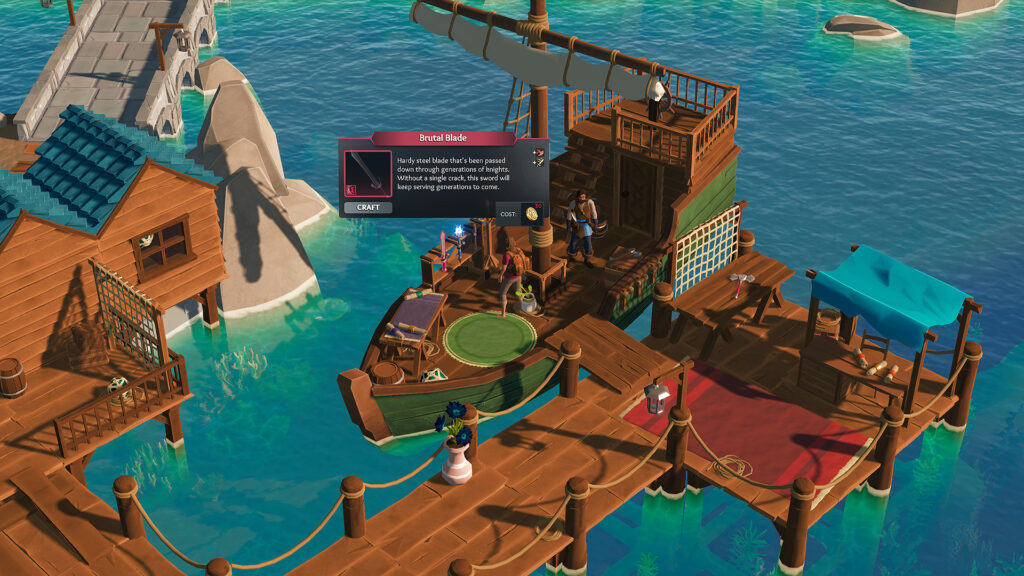Len’s Island Review
A good survival game must spin a lot of specific plates; exploration, building, and combat all have to be tuned well, or else the entire game falls apart. If the combat is stilted and unresponsive, exploring the world becomes a slog. Should the building interface feel clunky or unintuitive, grinding out resources feels akin to a chore without a satisfying payoff. While Len’s Island, a survival sim developed by Flow Studio, treads similar territory at some points, it also does away with several genre staples that usually ruin the experience. Though still a survival game at its core, Len’s Island is also about enjoying the adventure itself.
The first thing I noticed when my feminine Len stepped onto the island was that, strangely, there were only four hotbar slots. Most survival games demand a reasonable level of inventory management; realistically you can’t carry everything on your back. Len’s Island encourages you to do just that; rather than going directly onto your hotbar when you acquire a new resource, they’re instead placed in their own space in your inventory, accessible with a quick press of the tab key. Handling equipment like your pickaxe is also streamlined- when you’re done with your watering can, for example, just take it off of your hotbar, and it will automatically end up in your tool chest, cutting down on much of the cumbersome bloat that tends to fill your pack in most survival games. There was even a tool chest near the first cave entrance I found, so I never felt far away from what I needed.
Inventory management is for cowards

Without needing to organize multiple chests by their contents or having to hunt for where I left my iron sword, I spent much more time gathering resources like coal and salvage, made efficient with a system that rewards timing rather than grinding. Rather than hold left click until the tree falls or the ore is mined, timing your swings will result in a critical hit for faster progress. Getting crits can be the difference between a few good swings and being on your way, or not getting nearly as much work done as you could be. The timing also applies to combat, and each weapon seemed to have different timings to land critical hits. Learning the weapon timings before lighting a torch and heading into a cave could be the difference between life and death; enemies are overly aggressive and rush at you almost constantly. Thankfully, death only costs you a few gold pieces, so I wasn’t discouraged even if I found myself overwhelmed.
Outside of the game’s expansive dungeons, there was still a titular island to explore, and one much bigger than the title would have you think. Rather than being a singular large space, it’s actually several islands, interlocked by buildable bridges and sandbars outlining hidden paths. Whenever I thought I had finally seen everything, a telltale shoal would lead me to another island, with more resources and opportunities to explore even further. This was what I spent most of my time doing; wanting to know just how far I could push inward until the sun went down.
How do you make a house a home?

In-between exploring the caves and the island itself, I was constantly making adjustments to my home. The interface was a little tricky at first- though the rest of the game’s user interface is much cleaner, but after a few minutes of trial and error, I was able to deconstruct a ruined house for materials and then build my own relatively quickly with no headache. There are some unique prefabs like balconies and ornate windows, and it’s possible to make a perfectly functional, even appealing house with the right materials and space. Still, as much as I enjoyed decorating my house with bookshelves and rugs, I used it as little more than a space for my bed so I could end the day and finish exploring more of the Island the next morning.
While my experience was mostly positive, there were a few wrinkles that dampened my time on the island. Certain text, like item descriptions, can be laughably small, and I found myself having to lean into the screen to read signposts in the game because of how minuscule the writing was. And while making friends with the villagers is something I’m certain you’ll be able to do eventually, currently they all give you lifeless greetings that make them feel rather samey, with the exception of the pirate, whom you can play Blackjack with. Otherwise, most of the villagers are there to judge you solemnly while you peruse their wares, which doesn’t exactly match the budding village aesthetic similar games like Harvest Moon and more recently Animal Crossing have nailed.
Outside of those issues, Len’s Island and its streamlined, approachable systems put a much-needed focus on the adventure, instead of the struggle. While you still need to eat and stay warm, neither of those systems felt like a compromise I had to make to see the rest of the game. The changes to inventory and gathering make for a much smoother experience along the way, whether I was harvesting berries from my farm or building more furniture for my house. Though survival veterans from the likes of Rust or Valheim may not be swayed, Len’s focus as a thriving island adventure, where the focus is on fighting monsters and not the slots in your pack, give it just enough of an edge to stand out, rather than stand with its predecessors.

